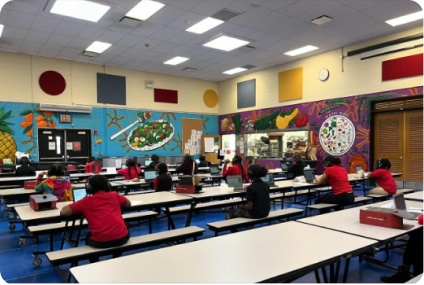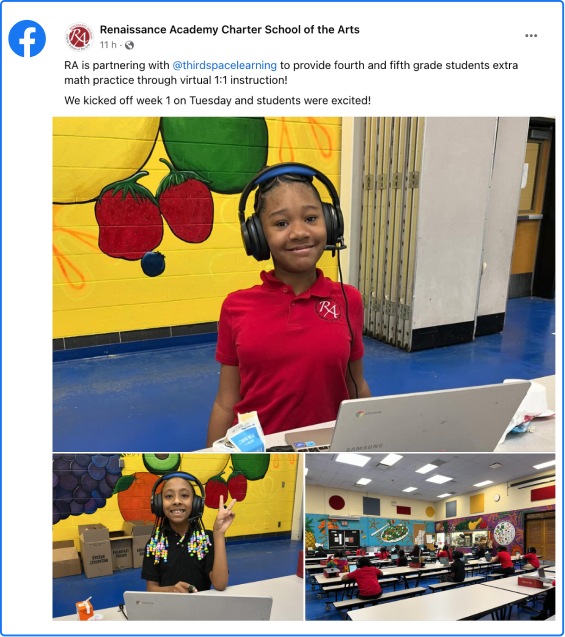How Renaissance Academy Provide Personalized One-On-One Math Instruction With Limited Time and Resources
Like many schools, Renaissance Academy Charter School of the Arts in New York had noticed increasing math learning gaps in their students. In 2023, they chose Third Space Learning math tutoring to maximize their staff capacity and provide extra one-on-one math support to their target students.
We caught up with their Math Instructional Coach, Liz Avery, to hear how the intervention has worked for Renaissance and why they’ve decided to continue the program this year…
About Renaissance Academy Charter School of the Arts:
Location: New York
Grades: K-6
Size: 506 students enrolled
Intervention details:
Grades: 4th Grade and 5th Grade
Intervention Goal: Accelerate progress, fill learning gaps, one-on-one support for more students, increase test scores, targeted learning
Key features: Individualized learning pathways, ease of setup, student/tutor rapport, affordable tutoring, confidence
Download the full school story here.
Effective Math Interventions: A Guide for Schools and Districts
A guide for school leaders, administrators, and interventionists on implementing successful math interventions in your school.
Download Free Now!We started with 10 fourth grade students
Before our testing season last year, we chose 10 students in 4th grade to have 6 weeks of sessions, twice a week. I was involved with selecting the students and the pathway they were going to follow, as well as monitoring the sessions while they were being tutored.
We decided to continue with the Third Space Learning intervention this year because we saw the impact last year!
Not enough time or resources to fill gaps in student understanding?
Third Space Learning’s online one-on-one math tutoring provides each student with their own tutor, all receiving high impact tutoring at the same time – without any impact on your workload.
Request a demo
We had gaps in student understanding and not enough time or resources to fill them all
Because we’re a charter school we rely heavily on our state test scores, and that pressure is there. Last year, our in-house data was not looking where we wanted it to be at that point in the school year. We needed an intervention to fill the gaps within our own time and resource constraints.
We found that something wasn’t translating to actual achievement on paper and decided to try Third Space Learning as a way to give students extra instruction. We felt that it being one-on-one would be really great. Although we already had small group time, we know one-on-one instruction is the best.
Third Space Learning solves that problem because we have 24 tutors working with students at once. We would never have the amount of resources to be able to do that in-house.

We chose students with learning gaps that needed an extra boost in math
I looked at the iReady data from a high level and picked the students that I thought would be best, based on their scores. I then met with their teachers to see if the lists seemed right or if there were other students in their classrooms who they thought would be a better fit.
Last year, we chose all 4th grade students as this is where we were seeing the biggest learning gaps. Two home room teachers were particularly struggling so it was really helpful to provide some extra support to their target students outside of the classroom.
This year we have chosen to put 12 students onto the 4th grade tutoring program and 12 onto the 5th grade tutoring program. We selected them by looking at assessment data and seeing which students were on the cusp of proficiency – they’re almost there, they just needed a little extra boost.
Only one of the current fifth graders also had sessions last year; all the other students no longer need support.
It’s easy to schedule the one-on-one tutoring into the school day
What we found works best is to use the block of time that we have dedicated for social and emotional learning – it’s a 20 minute block of time after students come in and have their breakfast. Using this block works for us because it’s a time that both 4th and 5th grade students share, and I felt it was better than taking them out of their actual small group or whole group time.
For me, it’s one time that I can monitor everyone instead of trying to find time in my schedule or multiple people to help me monitor if they are at different times of the day.
Students arrive at 9 and come down to the cafeteria at 9:10, then our Third Space Learning sessions start at 9:15. They each get their own table with their headsets laid out, they just sit down, log in and get to work. It’s really been pretty seamless!
Teachers and students are both really on board with it this year. The 5th graders feel responsible that this is their time to come and attend their session, and the 4th graders are really excited about it which is also helpful as they help remind their teachers.
There are two students in particular that are over the moon about being a part of this program.

The tutoring can be targeted to exactly what students need, which is what makes it so successful
It’s great to be able to select what you want the instruction to be based on and the different pathways. It’s not just ‘tutoring in 4th grade math’ – it’s specific concepts, standards and skills.
The Third Space Learning program suggests individualized learning pathways for every student, but it seemed like where we were in the year that all the students would benefit from work with Fractions. So that’s why we chose for everyone to follow the same learning pathway.
It was very collaborative between myself and the teachers. We wanted to make sure that the progression of lessons aligns with our standards, with the way our teachers are teaching the concepts, and that it flows with our curriculum.
There’s a mix of pictorial representations and abstract in the lessons, it’s a good balance between the two, especially for the students who need a bit more support. The pictures that I’m seeing on screen are a great support for those students, and then pushing them to that more abstract math work.

At this point in the year, it’s good to get the review of all the standards they’ve been exposed to in the year, then Third Space Learning tutors can focus on the ones they’re struggling with. This also gives students a lot of independent practice time to try to build that stamina so they’re ready when they have to take lengthy state tests in a couple of weeks.
Out of all the students who took part, everyone increased their scores
The students really liked it. They loved working one-on-one, being on the computer with the tutor, using the headphones and they really liked having the special time to leave the classroom. They all said that they felt they got better at math!
When I listen in to the sessions I notice a lot of students are doing a really good job of explaining their thinking to their tutors which is awesome. It sounds like they are understanding the concepts and they are able to articulate that in their own words – which tells me that they are getting something out of it.
Teachers, students and parents are all on board
Teachers and students are both really on board with it. Everyone at the school was; they were excited about it and felt like it was a great opportunity. It was easy to get buy-in from teachers.
Before we started we did send home letters to parents letting them know that this was happening, that their children were selected and if there was any reason they didn’t want them to participate to reach out but no one did. So parents are on board as well!
It’s easy to monitor student engagement
When the students are working, a lot of the time I’m logging in to the platform to check the previous lesson’s feedback.
I log in to see tutor feedback and make sure the students are engaged with their tutors. I try to do that each day for the previous session.
We’ve used the additional resources with small groups and for extra assessment items
We try to create assessments that we use three times a year that are supposed to mimic state tests, and I run out of actual state tests items. The practice New York state tests were very comparable in the way that they’re written, so I have been using some of those.
I also sent all of those resources to teachers to check out. I thought it was really great that they were all free and really easy to navigate!
We continued with Third Space Learning because of the impact it has on our students
We decided to keep using Third Space Learning because it provides our students with one-to-one instruction in targeted areas that they need, based on our data.
It allows us to fill gaps in learning that we don’t have the time and resources to address on our own and provides extra support for those students who really need it.
It’s also fun and different. The students get to interact with a tutor one-on-one and there are a lot of discussion-based items. Students seem to really enjoy it – sometimes novelty is what makes things successful too!
Math tutoring built for schools and districts
Scalable, affordable and effective one-on-one math tutoring for the students who need it most:
- Maximize staff capacity: Teachers are free to focus on core instruction or small groups
- Accelerate growth: All tutoring is personalized to close individual learning gaps
- Standards-aligned instruction: Tutors use a curriculum of specially-created scaffolded lessons
- Math specialist tutors: All our STEM-specialist tutors undergo rigorous training and pass background and FBI fingerprint checks
Request a demo




